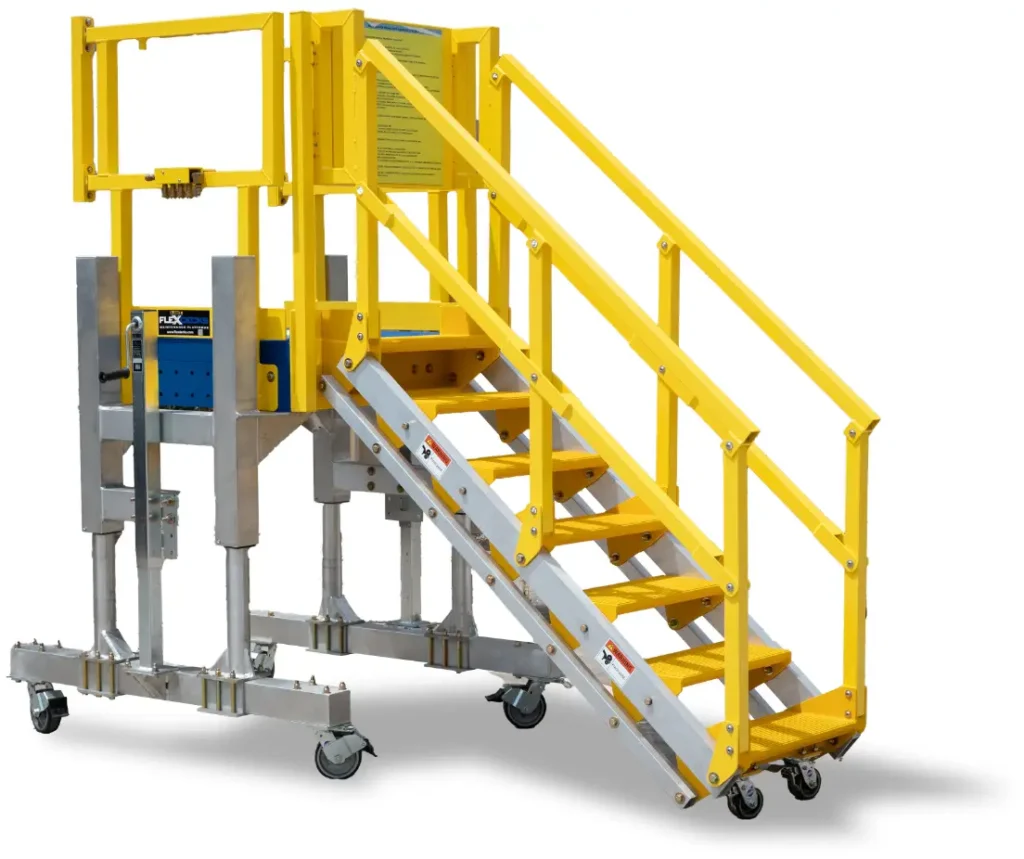
A mobile, elevated surface adaptable to various heights facilitates tasks at different levels. Imagine a painter reaching the upper story of a building or a mechanic working under a vehicle. These scenarios exemplify the utility of such adaptable equipment.
Enhanced safety and efficiency are key advantages provided by these adaptable surfaces. Falls from height are a significant workplace hazard, and these tools mitigate that risk by offering a stable, secure workspace. Furthermore, adjustable height improves ergonomics, reducing strain and boosting productivity. The development of these platforms reflects a growing awareness of workplace safety and the pursuit of more efficient practices.
This discussion will further examine specific types, materials, safety regulations, and selection criteria for these essential tools.
1. Height Adjustability
Height adjustability is a defining feature of adjustable work platforms, directly impacting their versatility and suitability for diverse tasks. The ability to modify the working height is crucial for reaching various levels safely and efficiently, enabling operations across a range of applications.
-
Range of Motion
The vertical range offered by the platform dictates its applicability. A platform with a limited range might be suitable for tasks close to the ground, such as automotive repair, while one with a broader range is necessary for reaching higher elevations, like building maintenance or tree trimming. This range influences the platform’s overall utility and suitability for different projects.
-
Adjustment Mechanism
The method employed for height adjustmenthydraulic, mechanical, or electricaffects the platform’s speed, precision, and load capacity. Hydraulic systems offer smooth, controlled movement, while mechanical systems might involve manual cranking. Electric systems provide automated adjustment. Understanding these mechanisms is essential for selecting the appropriate platform for specific tasks and weight requirements.
-
Incremental Adjustments
The fineness of height adjustment impacts precision and ergonomic adaptation. Fine-grained adjustments allow workers to position the platform at the optimal height for the task, minimizing strain and maximizing comfort. This level of control is crucial for tasks requiring detailed work and prolonged periods at height.
-
Stability at Height
Maintaining platform stability across the entire height range is paramount for safety. The structural design and locking mechanisms must ensure a secure and stable work surface, preventing tipping or swaying at elevated positions. This stability is crucial for preventing accidents and ensuring worker confidence.
These facets of height adjustability underscore its importance in the overall functionality and safety of adjustable work platforms. Selecting a platform with the appropriate height range, adjustment mechanism, and stability features is critical for ensuring efficient and safe operation in any given application. Understanding these elements empowers informed decision-making and contributes to a safer, more productive work environment.
2. Platform Stability
Platform stability is paramount for safe and effective use of adjustable work platforms. A stable surface minimizes the risk of accidents and ensures worker confidence, contributing directly to productivity and overall safety. This stability relies on several interconnected factors, each crucial for maintaining a secure work environment at any height.
-
Base Design and Footprint
The platform’s base structure significantly influences its stability. A wider base generally provides greater stability, resisting tipping forces. Outriggers, when deployed, further enhance stability, especially on uneven terrain. Consider a scissor lift; its wide base and potential for outriggers ensure stability during operation.
-
Weight Distribution and Capacity
Understanding the platform’s weight capacity and ensuring even weight distribution is essential. Exceeding the weight limit or concentrating weight unevenly can compromise stability, increasing the risk of tipping or structural failure. Proper load management is therefore crucial for safe operation.
-
Locking Mechanisms and Safety Features
Secure locking mechanisms at each adjustable height are essential for preventing unintended movement or collapse. These mechanisms must be robust and reliable, ensuring the platform remains firmly fixed at the chosen working height. Additional safety features, like guardrails, prevent falls and contribute to a secure work environment.
-
Surface Grip and Material
The platform’s surface material and texture play a critical role in preventing slips and falls. Non-slip surfaces provide traction, especially in wet or oily conditions. Durable materials resistant to wear and tear ensure long-term platform stability and safety.
These elements of platform stability are integral to the safe and effective operation of adjustable work platforms. A thorough understanding of these factors, coupled with proper usage and maintenance, ensures a secure work environment at height, maximizing productivity while minimizing risk. Selecting a platform designed with these stability features in mind is crucial for any application.
3. Material Durability
Material durability directly impacts the lifespan, safety, and overall cost-effectiveness of an adjustable work platform. Selecting appropriate materials ensures long-term structural integrity, resistance to environmental factors, and reliable performance under various working conditions. This durability is fundamental to maintaining a safe and productive work environment.
Platforms frequently encounter challenging conditions, including exposure to weather, chemicals, and heavy loads. Aluminum, steel, and fiberglass composites are common materials selected for their specific properties. Aluminum offers lightweight strength and corrosion resistance, making it suitable for outdoor applications. Steel provides high load-bearing capacity but requires protective coatings to prevent rust. Fiberglass composites offer electrical insulation and resistance to chemical corrosion, making them suitable for specialized environments. Consider a platform used in a coastal area; aluminum’s resistance to saltwater corrosion would be advantageous. Conversely, a platform used in a chemical processing plant might benefit from fiberglass’s chemical resistance. Material selection must align with the anticipated operating conditions to ensure platform longevity and safety.
Understanding the relationship between material durability and adjustable work platform functionality is crucial for informed decision-making. Choosing durable materials suited to the intended application minimizes maintenance costs, extends platform lifespan, and, most importantly, ensures worker safety. This understanding contributes to a more efficient and secure work environment, ultimately benefiting both productivity and worker well-being.
4. Safety Features
Safety features are integral to adjustable work platform design, mitigating inherent risks associated with working at height. These features are not mere additions but essential components that directly impact worker well-being and overall operational safety. A robust safety system minimizes the likelihood of falls and other accidents, fostering a secure work environment and promoting productivity. For example, guardrails provide a physical barrier preventing falls, while safety harnesses offer a secondary level of protection should a fall occur.
Several key safety features contribute to the secure operation of adjustable work platforms. Emergency stop mechanisms allow for immediate cessation of platform movement in critical situations. Level indicators ensure the platform remains stable on uneven terrain, reducing the risk of tipping. Non-slip surfaces minimize the risk of slips and falls, especially in wet or oily conditions. Regular inspections and maintenance of these features are crucial for ensuring their continued effectiveness. Consider a construction site where a worker uses a scissor lift; the guardrails, emergency stop, and level indicators are critical for preventing accidents and ensuring safe operation.
Prioritizing safety features is not merely a compliance requirement but a fundamental aspect of responsible adjustable work platform usage. Understanding these features, their function, and their importance empowers workers to operate platforms safely and efficiently. This knowledge contributes to a culture of safety, minimizing workplace accidents and promoting a secure and productive work environment. The integration and proper utilization of safety features are essential for maximizing the benefits of adjustable work platforms while mitigating inherent risks.
5. Mobility Mechanism
The mobility mechanism of an adjustable work platform is fundamental to its utility, dictating its maneuverability and adaptability across various work environments. Efficient movement and precise positioning are crucial for optimizing workflow and ensuring access to the work area. The selection of an appropriate mobility mechanism depends on factors such as terrain, required range of motion, and the overall work environment.
-
Wheel Systems
Wheels are a common mobility solution, enabling easy movement on smooth surfaces. Variations exist, including swivel casters for enhanced maneuverability and locking casters for secure positioning. Consider a rolling scaffold used for interior painting; its wheeled base allows easy relocation within a room. However, wheeled platforms may be unsuitable for uneven or soft terrain.
-
Track Systems
Track systems offer enhanced stability and traction on uneven or soft surfaces, such as construction sites or outdoor landscaping projects. Tracked platforms distribute weight more evenly, reducing ground pressure and minimizing the risk of sinking or becoming stuck. This makes them suitable for navigating challenging terrains where wheeled platforms might struggle.
-
Outrigger Systems
While not a primary mobility mechanism, outriggers play a crucial role in stabilizing adjustable work platforms, particularly during operation. Outriggers extend from the platform’s base, providing additional support points and enhancing stability on uneven surfaces. This is particularly important for elevated platforms, ensuring a secure work environment at height.
-
Self-Propelled Mechanisms
Some adjustable work platforms feature self-propelled mechanisms, typically powered by electric motors or internal combustion engines. These mechanisms allow for independent movement, eliminating the need for manual pushing or towing. Self-propelled platforms are particularly advantageous for larger, heavier platforms or when navigating longer distances.
The choice of mobility mechanism directly impacts the overall effectiveness and safety of an adjustable work platform. Careful consideration of the work environment, terrain, and required range of motion is essential for selecting the appropriate mechanism. A well-chosen mobility system enhances productivity, facilitates access to work areas, and contributes to a safer, more efficient work environment.
Frequently Asked Questions
This section addresses common inquiries regarding adjustable work platforms, providing concise and informative responses to clarify key aspects of selection, usage, and safety.
Question 1: What height range is suitable for various tasks?
The appropriate height range depends on the specific task. Lower heights suffice for tasks like automotive repair, while higher elevations are necessary for building maintenance or tree trimming. Assess the required working height before platform selection.
Question 2: How is platform stability ensured at different heights?
Stability is achieved through a combination of factors, including a wide base, outriggers, robust locking mechanisms, and even weight distribution. Adhering to the manufacturer’s specified weight capacity is crucial.
Question 3: What materials are commonly used in platform construction, and why?
Common materials include aluminum, steel, and fiberglass composites. Aluminum offers lightweight strength and corrosion resistance. Steel provides high load capacity. Fiberglass composites offer electrical insulation and chemical resistance. Material selection depends on the intended work environment.
Question 4: What key safety features should be considered?
Essential safety features include guardrails, emergency stop mechanisms, level indicators, and non-slip surfaces. Regular inspection and maintenance of these features are crucial for ensuring ongoing safety.
Question 5: What are the different types of mobility mechanisms available?
Mobility mechanisms include wheel systems, track systems, and self-propelled options. Wheel systems suit smooth surfaces, while track systems are better for uneven terrain. Self-propelled platforms offer independent movement. The choice depends on the specific work environment.
Question 6: How does one choose the right adjustable work platform?
Platform selection involves careful consideration of several factors, including required height range, platform stability, material durability, essential safety features, and the appropriate mobility mechanism. Matching these factors to the specific task and work environment ensures safe and efficient operation.
Careful consideration of these frequently asked questions facilitates informed decision-making, contributing to the safe and effective utilization of adjustable work platforms across diverse applications. Understanding these aspects promotes a secure work environment and optimizes productivity.
Further sections will delve into specific platform types and their applications, offering more detailed insights into these versatile tools.
Essential Tips for Utilizing Elevated, Adaptable Work Surfaces
Safe and effective use of adaptable, elevated work surfaces requires careful planning and adherence to best practices. These tips emphasize crucial aspects for maximizing productivity while ensuring worker safety.
Tip 1: Conduct a Thorough Risk Assessment
Prior to utilizing an elevated, adaptable work surface, a comprehensive risk assessment of the work area is essential. This assessment should identify potential hazards, such as uneven terrain, overhead obstructions, and environmental factors. This preemptive evaluation informs safe platform placement and operation.
Tip 2: Select the Appropriate Equipment
Choosing the correct equipment for the task is paramount. Consider the required height range, weight capacity, and mobility needs. Matching the platform’s capabilities to the specific task ensures safe and efficient operation. Using a platform with insufficient height capacity for the task, for example, compromises both safety and productivity.
Tip 3: Inspect Equipment Before Each Use
Prior to each use, a thorough inspection of the elevated, adaptable work surface is crucial. This inspection should focus on key components like locking mechanisms, guardrails, and platform stability. Identifying and addressing any defects before operation prevents potential accidents.
Tip 4: Ensure Proper Training and Certification
Operating personnel must receive adequate training and possess the necessary certifications for utilizing elevated, adaptable work surfaces. Proper training ensures safe operation, minimizing the risk of accidents due to improper usage. Competent operation benefits both individual safety and overall project efficiency.
Tip 5: Maintain a Stable Work Area
Maintaining a stable work area on the elevated surface is crucial for preventing accidents. Avoid overloading the platform and ensure even weight distribution. Securing tools and materials prevents shifting during operation, further enhancing stability and safety.
Tip 6: Use Appropriate Safety Equipment
Utilizing appropriate safety equipment, such as harnesses and lanyards, is essential when working at height. These safety measures provide a secondary level of protection, minimizing the risk of serious injury in the event of a fall.
Tip 7: Adhere to Manufacturer Guidelines
Consulting and adhering to the manufacturer’s guidelines for operation and maintenance is crucial for safe and effective platform usage. These guidelines provide specific instructions tailored to the equipment, ensuring optimal performance and longevity.
Adherence to these tips contributes significantly to a safer and more productive work environment when utilizing elevated, adaptable work surfaces. Prioritizing safety and following best practices ensures efficient task completion while minimizing risks.
The subsequent conclusion will summarize the key benefits of incorporating these adaptable tools into various work settings.
Conclusion
Adjustable work platforms represent a significant advancement in workplace safety and efficiency. Their adaptability across diverse applications, from construction and maintenance to specialized industrial tasks, underscores their versatility. This exploration has highlighted the critical aspects of platform selection, emphasizing the importance of height adjustability, platform stability, material durability, integrated safety features, and appropriate mobility mechanisms. Careful consideration of these factors ensures optimal performance and worker safety, maximizing the benefits of these essential tools.
The ongoing development and refinement of adjustable work platform technology promise further enhancements in safety and productivity. Continued emphasis on robust safety features, innovative mobility solutions, and durable materials will solidify their indispensable role across various industries. Investing in and implementing these adaptable tools contributes significantly to a safer, more efficient, and ultimately more productive work environment.



